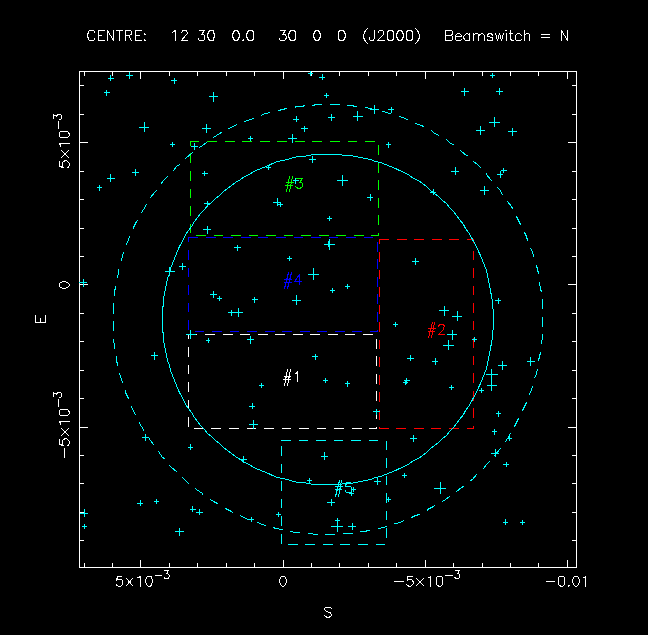CCD Characteristics
CCD Layout
The WFC comprises 4 thinned EEV 4kx2k CCDs for the science array +
a thinned 2kx2k Loral CCD for use as a dedicated frame transfer
autoguider. The science devices have 13.5 micron pixels = 0.33"/pixel
at INT prime and each cover an area of 22.8 arcmin x 11.4 arcmin on
sky. The total sky coverage per exposure is 0.29 sq deg. The Loral
autoguider has 15 micron pixels = 0.37"/pixel although charge
adjacency effects limit the true Loral resolution to 30 microns.
The active area of EEV CCDs is 2048x4100 pixels, overscan regions
give 2148x4128 pixels on readout, with Trimsec [51:2098,1:4100] and
Biassec [1:50,1;4128] the recommended data and overscan sections for
all devices.
Current readout time is 160s in SLOW mode (recommended) and 155s in STANDARD.
#1 Suffers from horizontal streaking from very bright stars and shadow
of radiation shield in bottom right hand edge
#2 Slight vignetting at top right
#3 Vignetted in bottom left corner
#4 "Shadow" of support screw in middle - flatfields out ok
For an example of a typical EEV42-80 QE curve (courtesy of Simon Tulloch)
click here .
Properties of EEV Mosaic CCDs
Properties of EEV Mosaic CCDs - March 1999
(October 1998 measures in brackets)
| Science CCD |
Bias Level |
Gain e-/ADU |
Readout Noise e- |
Max ADU |
| #1 |
1559 (1619) |
3.12 (3.12) |
7.9 (7.8) |
58,000 |
| #2 |
1636 (1667) |
3.19 (3.11) |
6.4 (7.1) |
59,000 |
| #3 |
1744 (1796) |
2.96 (2.98) |
8.3 (7.9) |
59,000 |
| #4 |
1190 (1219) |
2.22 (2.20) |
8.4 (7.9) |
58,000 |
Notes to table:
Measured using the default SLOW readout speed and FLASH clear.
The error on measuring the gain for each device is around 0.03 and the
error on the readout noise measurement is about 0.3, ie. within the errors
the gain and readout noise have remained constant.
Note that the gain
of CCD#4 changed during a hardware fix early in October 1998 and is
significantly different (2.2 cf. 3.3) from the value it had previously
from the April 1998 commissioning.
Properties of EEV Mosaic CCDs using new SDSU DAS
Properties of EEV Mosaic CCDs using new SDSU DAS - Summer 2000, Autumn 1999, Autumm 2004
(October 1998 measures in brackets)
| Science CCD |
Bias Level |
Gain e-/ADU |
Readout Noise e- |
Max ADU |
| #1 |
1527 (1619) |
2.9, 2.8, 2.61 (3.1) |
7.3, 8.4, 6.8 (7.8) |
65,000 |
| #2 |
1590 (1667) |
2.9, 2.8, 3.00 (3.1) |
6.5, 9.8, 6.9 (7.1) |
65,000 |
| #3 |
1623 (1796) |
2.5, 2.4, 2.34 (3.0) |
5.2, 7.7, 9.6 (7.9) |
65,000 |
| #4 |
1644 (1219) |
2.8, 2.8, 2.92 (2.2) |
5.8, 8.7, 8.5 (7.9) |
65,000 |
Notes to table:
Measured using the default readout and clear speeds
The error on measuring the gain for each device is around 0.05 and the
error on the readout noise measurement is about 0.3 as before.
Note that a feature of the new DAS using SDSU controllers is that saturated
ADC values, ie. those attempting to be >65535 are set to 89 - don't ask !
CCD broadband zero-points
| CCD |
U |
B |
V |
R |
I |
| #1 |
23.8 |
25.6 |
25.7 |
25.6 |
24.9 |
| #2 |
23.8 |
25.6 |
25.6 |
25.6 |
25.0 |
| #3 |
23.6 |
25.6 |
25.6 |
25.6 |
25.0 |
| #4 |
23.6 |
25.6 |
25.7 |
25.6 |
25.0 |
Notes to table:
These zero-points are the magnitude of an object that gives 1 detected e-/s.
The measurements were made during commissioning in April 1998 in less than
perfect conditions, but should be accurate to 0.1 magnitudes.
U suffering from replaced 3rd corrector element which is not
optimally coated - probably loses 0.2 magnitudes.
B,V,R are the Harris glass filters, U and I are RGO glass filters - see
filter specifications for more details.

